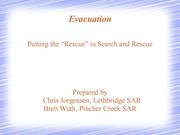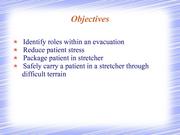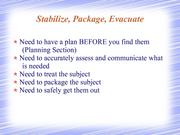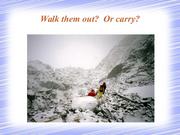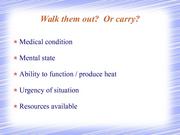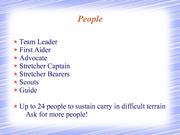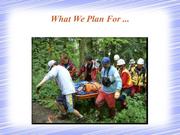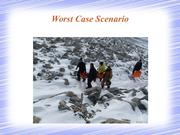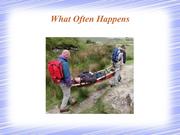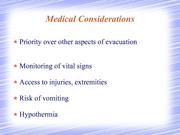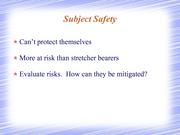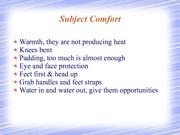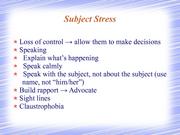SAR Fundamentals/Evacuation
From PCSAR
(→Aids) |
(→Scope) |
||
| Line 10: | Line 10: | ||
== Scope == | == Scope == | ||
{{prompt|What is included in this lesson, what's not and why.}} | {{prompt|What is included in this lesson, what's not and why.}} | ||
| - | : Addresses part of [[Members:CSA/Z1625/Text/Searcher training curriculum/First aid and survival skills/First aid|CSA Z1625 4.4.1]] T1. First aid procedures related to relevant search environment. | + | : Addresses part of [[Members:CSA/Z1625/Text/Searcher training curriculum/First aid and survival skills/First aid|CSA Z1625 4.4.1]] |
| + | :* part of T1. First aid procedures related to relevant search environment. | ||
: SAR Fundamentals Manual: Ch.26 "Evacuation" | : SAR Fundamentals Manual: Ch.26 "Evacuation" | ||
: Basic SAR Skills Manual: Ch.23 "Rescue and Evacuation" | : Basic SAR Skills Manual: Ch.23 "Rescue and Evacuation" | ||
Revision as of 21:09, 15 March 2018
Contents |
Subject
What is this lesson plan about?
Moving the subject after they have been located.
Authors
List who wrote this lesson plan.
Scope
What is included in this lesson, what's not and why.
- Addresses part of CSA Z1625 4.4.1
- part of T1. First aid procedures related to relevant search environment.
- SAR Fundamentals Manual: Ch.26 "Evacuation"
- Basic SAR Skills Manual: Ch.23 "Rescue and Evacuation"
- include litter carry / patient packaging
Prerequisites
What should students already know/have accomplished before the lesson is presented.
Objectives
At the conclusion of this lesson the participants:
- can identify roles within an evacuation
- can reduce patient stress
- can package patient in stretcher
- can safely carry a patient in a stretcher through terrain difficulties
Time Plan
Total Time: 45 minutes
- 2013-02: 25 min
add details about packaging
| Time | Material
|
|
00:00 3 min |
Introduce topic title Introduce Instructor Present Objectives
|
|
00:03 3 min |
Roles in Evacuation inner circle (medical) vs. outer circle (rescue)
Additional resources will be sent in
|
|
00:06 2 min |
Medical Considerations
|
|
00:08 2 min |
Subject Safety
|
|
00:10 3 min |
Subject Stress
|
|
00:13 2 min |
Subject Comfort
|
|
00:15 3 min |
Types of Stretchers
|
|
00:18 10 min |
Order of Packaging - No backboard demonstrate packaging
|
|
00:28 3 min |
Complex Packaging spinal restrictions
rope rescue
People with these higher level skills will be brought in to work with you on packaging
|
|
00:31 6 min |
Carrying
exercise: short carry and lower
|
|
00:37 7 min |
Moving exercise: resume the carry, adding complications of terrain to bring out the following points
|
|
00:37 1 min |
Questions |
Aids
What materials are needed or useful in presenting this lesson.
- non-publishable material
- wire mesh stretcher
- webbing
- 6 x 5m
- 1 x 10+m or 2 x 7m
- improvised terrain or obstacles
- Image:SAR Basics Evacuation.odp (pdf)
- Slide show for Evacuation Lesson by Chris Jorgensen
- Training/Ideas/First aid
- Image:Members:Short History of Stretchers.pdf
Question bank
List of questions suitable for an review/exam of this section.
See Question bank
Frequently Asked Questions
What are some of the questions that students typically ask. Include the answers.
Feedback
When has this lesson been presented. What was the feedback.
License
What can others do with this lesson?
Recommended license below. Fill in the year and the author's name(s):
Copyright © 2013-2018, Chris Jorgensen, Brett Wuth. This work is licensed under a Creative Commons Attribution-NonCommercial 2.5 Canada License. To view a copy of this license, visit http://creativecommons.org/licenses/by-nc/2.5/ca/ or send a letter to Creative Commons, 559 Nathan Abbott Way, Stanford, California 94305, USA.
Reference Material
If you need to cite sources, do so here.
[1]
Notes
Any additional notes, etc.
